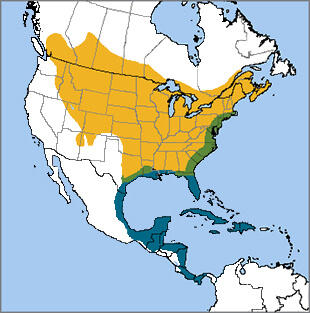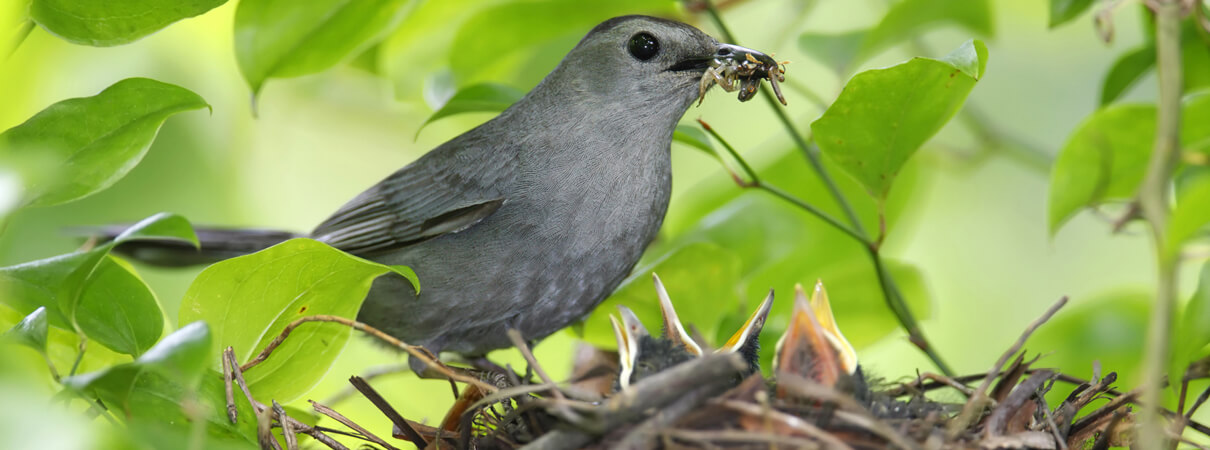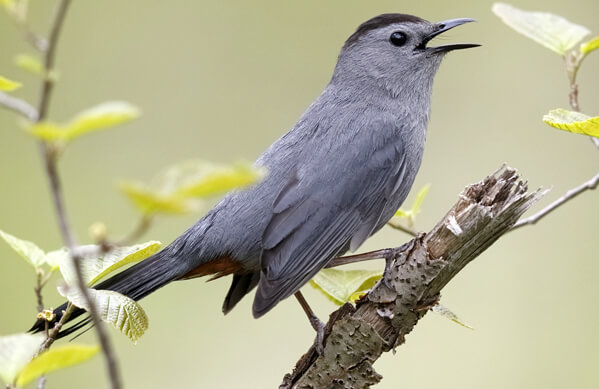
The Gray Catbird is a familiar member of the Mimidae (mimic) family, a group of birds that includes noted songsters such as Northern Mockingbird and Sage Thrasher. Like its relatives, the Gray Catbird mimics a variety of sounds, but this bird is best known for the cat-like mewing calls that give the species its common name.
Gray Catbirds often sing from a high perch while displaying; this behavior gave rise to an idiom heard in the southern United States, "sitting in the catbird seat," which refers to someone in an advantageous position.
The catbird's genus name, Dumetella, means “small thicket,” a nod to its preferred habitat of deep thickets and shrubs.
Bird of Brushy Places
Gray Catbirds migrate to southern areas of the United States, Mexico, Central America, and the Caribbean for the winter, where they are found in the same brushy habitats as on their breeding grounds.
Along with other migratory birds such as Wood Thrush, Common Yellowthroat, and Magnolia Warbler, Gray Catbirds face a variety of threats during their biannual journey, from collisions with windows, wind turbines, and communications towers, to introduced predators like cats.
A study by the Smithsonian Migratory Bird Center (SMBC) found that nearly half of all catbird fledglings fell victim to free-roaming cats, while SMBC's catbird tracking study is providing more information on where the birds go on migration and what threats they face.
Sign up for ABC's eNews to learn how you can help protect birds
(Audio: Hear the mewing call of the catbird along with mimicry of other birds. Recorded by Paul Driver, XC248135. Accessible at www.xeno-canto.org/248135.)
Not the Nicest Neighbor
Like Prairie and Golden-winged Warblers, Gray Catbirds prefer to nest in open, second-growth forests with dense, regenerating vegetation. They build their bulky nests low to the ground within dense brush. Unlike most birds, Gray Catbirds learn to recognize Brown-headed Cowbird eggs and eject them from their nests, making them less vulnerable to this brood parasite.

Gray Catbirds are prolific nesters and usually raise two broods per season. They are aggressive neighbors and have been observed destroying eggs and nestlings of other bird species, including Vesper Sparrow, Song Sparrow, and American Robin. Scientists are not sure whether this behavior stems from competitiveness or is merely opportunistic foraging.
Fruit Forager
Gray Catbirds can often be spotted as they forage for food on the ground or in low shrubs and branches. They feed on insects, larvae, and spiders, adding many different kinds of berries and fruits to their diet when available.
Unlike other ground-feeding birds such as Black-throated Sparrow, which use their feet to scratch the ground in search of food, Gray Catbirds use their bills as they forage, flipping over leaves, twigs, and other debris to find a meal.
Keeping the Catbird Common
Although the Gray Catbird remains a common species, it benefits from many of ABC's conservation programs. Our Migratory Bird Program protects important wintering areas such as Tapon Creek in Guatemala, where Gray Catbird winters alongside other migrants such as Kentucky Warbler and Ovenbird.
ABC's advocacy programs, including Cats Indoors, Glass Collisions, and Bird-Smart Wind, are working to reduce or remove some of the fatal obstacles faced by catbirds and other neotropical migrants like Blue-winged Warblers.
Donate to support ABC's conservation mission!



















































